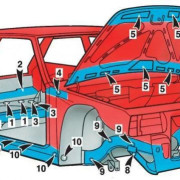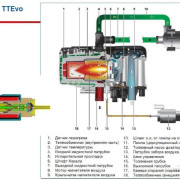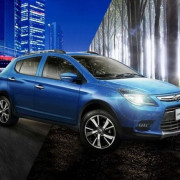Dodge charger srt hellcat 2019
Содержание:
Competitors:
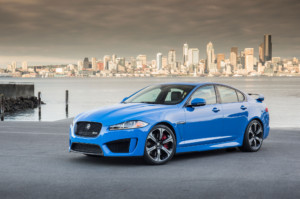
Jaguar XFR – S
During the track test, the Jaguar XFR – S led the Charger SRT Hellcat, by 0.4 seconds. On getting into the detail, we discovered that the crispy steering ability of XFR – S made with lead the Charger. Actually, it was quite hard to get a competition for the Dodge Charger SRT Hellcat, as it is certainly the unique car in terms of body style.
The Dodge Charger SRT Hellcat is presently the most powerful car manufactured in America. As said earlier, the SRT Hellcat would raise the value of your garage. And so it does. Power and performance are unleashed in this muscle. On top of that, SRT Hellcat bears the economical price tag of its class.
Same as it ever was
Inside is where the Charger is showing its age. It’s roomy, with a straightforward layout and clearly marked controls. The front bucket seats are comfortable with generous side bolsters and trimmed with nice leather, while lots of soft-touch surfaces, an optional suede headliner and real carbon fiber trim bring some premium touches to this test car. There’s also a nice big trunk in the back with 16.5 cubic feet of space. Unfortunately, the interior design is a bit stale now and there are some budget-rate areas, such as the hollow window controls and flimsy plastic lower door panel compartments.
Enlarge Image
The cabin is getting long in tooth, but the infotainment technology is still on point.
Jon Wong/Roadshow
What isn’t stale is the Uconnect infotainment system with its crisp-looking and responsive 8.4-inch touchscreen controlling a bumping 19-speaker Harman Kardon audio setup, navigation system that quickly calculates routes, Wi-Fi hotspot, Apple CarPlay and Android Auto. And to keep anyone phones or tablets from going dead in the Charger, there are numerous USB and 12-volt outlets within easy reach of people in both rows of seats.
Sadly, anyone looking for a big driver-assistance tech menu will be disappointed. The Charger Hellcat comes with the federally mandated backup camera and standard blind-spot monitoring and that’s it. Things like adaptive cruise control, lane-departure warning and forward-collision warning are not available.
Exterior:
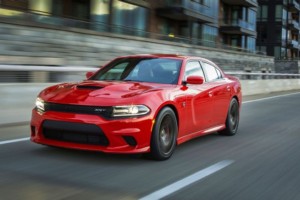
2017 Dodge Charger SRT Hellcat Exterior
Generally, the muscle cars have a classic structure for body styling. The round headlights and the bar-shaped tail lights are the standards for muscle cars. But the Dodge Charger series has a distinct culture. Dodge has certainly modified the muscle car tradition.
The front grille spacing resembles the conventional muscle cars. But the sexy headlights are quite different. More or less, they resemble the present day concept cars. When jumping to the bonnet, we get an engine hood, which is scientifically an air pass towards the engine. It helps to bring in the air to work as the coolant.
On the bonnet and the front doors, there is the Dodge styling. Indeed it’s a cosmetic touch, but physically it works as the drag coefficient reducer. At the rear, there is a thin spoiler on the rear of the car. It works as the air friction balancer to maintain the balance of the car over fast speed.
The body styling of SRT Hellcat helps in the performance of the car. Almost 5 – 10% of the performance is increased because of the body styling.
Performance:
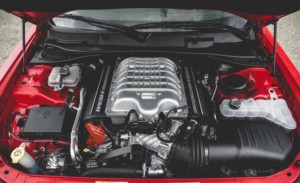
Hood of 2017 Dodge Charger SRT Hellcat
Dodge Charger SRT Hellcat is the most powerful model of the Charger series. It comes with a 6.2 L supercharged V8 with OHV 16 valves. The engine is topped with a 707 horses @ 650 lb – ft of torque.
In a detailed testing, it seemed like the Charger SRT Hellcat resembles its sibling Dodge Challenger SRT Hellcat. And even the performance figures of both the cars are same. Although the Charger is heavier then Challenger, but when both the cars are tested alongside, their performance is same.
From 60 – 0 mph, Charger SRT Hellcat took only 104 feet to stop. It is because of the large Brembo brakes installed in Charger. The steering of the car is smooth. The electrified steering ability of Charger makes it handle smoothly. Such particulars raise the handling ranks of Charger. And such steering capability is preferable for the city driving.
When it comes to the mileage, then SRT Hellcat lacks in this column. The city cars are expected to lie somewhere between the EPA of 40 mpg. That is called the so-called Economy. But the Charger SRT Hellcat lies between 18 mpg. The city consumers might find it difficult to ride with such low mileage. Performance cars are hardly economical on fuel. Especially, the V8 Hemi engine would require much more fuel to run as compared to a standard in-line cylinder engines.
There is even a bigger engine in the series, modeled as Dodge Charger SRT 392. It is a 6.4 L V8 engine, but the tuning of SRT 392 is lower than Hellcat.
Big performance bang for your buck
Really, when you think about what the 2020 Dodge Charger SRT Hellcat Widebody brings to the table for $73,590 (including $1,495 for destination and gas guzzler tax), it’s a performance bargain. And that’s even truer with the Widebody, which allows the Charger to take corners in a respectable fashion thanks to its suspension changes and bigger tires.
Enlarge Image
The Dodge Charger SRT Hellcat Widebody will set you back $73,590 to start.
Jon Wong/Roadshow
The Hellcat Widebody tester pictured here stickers for $83,150 with a handful of options that I’d gladly leave off, such as different wheels, a sunroof and some small visual upgrades. My ideal car keeps the frostbite paint job seen here, though, as well as the $1,595 carbon-suede interior package. I’ll also keep the great $1,995 Harman Kardon Audio Group, bringing my ideal car’s bottom line to $77,180.
A True All-Rounder
Inside, the Redeye is all-business, reminding you that your $80,000 is under the hood. (At least $21,807’s worth anyway: That’s what the 807-horsepower crate engine costs delivered to your front door.) Front seats are very good, with enough side bolstering to hold you in on tight turns. Rear seat room is amble for two adults, passable for three. The center screen controls multiple functions, and even includes the ability to limit the engine to «just» 500 horsepower, smart for valets and your friend’s first drive in the car. (Kids? Right. When you’re 21. Maybe.)
It also controls the various functions—with most performance cars, you can cheerfully press «track» and enjoy your local backroads, but choose «track» in the Hellcat, and you’d best be on the track. The Performance Pages let you configure various functions independently, and you’ll find your happy place. There’s plenty of trunk space (16.5 cubes) for family vacations. To the Bonneville Salt Flats.
Steve Cole Smith
On the road, the Redeye is very drivable, a credit to the so-versatile Bilstein adaptive suspension and the fat Pirelli P-Zero radials. (305/35ZR20). Yes, this platform is almost old enough to buy smokes, but Dodge and SRT have done so much work on it that it may as well be new. Track-handling is just superb, much to your surprise.
For a super sedan, $80,000 is pretty dang reasonable, and it’s hard to quantify how it makes you smile every time you tap the throttle and hear the supercharger whine. If I won the lottery tomorrow—and it’s possible, OK!—there’d be many cars in my future, but my first call would be to my neighborhood Dodge dealer.
Got a tip? Send us a note: tips@thedrive.com
Muscle car wars
Ford hopes to trounce the Challenger Hellcat line when it officially ships the first Shelby GT500s to dealers for the 2020 model-year. It will be the most powerful street-legal Mustang ever to roll out of a Ford plant, at 767 horsepower.
GM has yet to reveal details on the new 2020 Corvette, the first-ever mid-engine model known to fans as the «C8.» But the top-line version of the 2019 ‘Vette, the ZR1, makes 755 horsepower and can top out at 212 mph.
More and more manufacturers are pushing into the performance market. Hyundai recently launched a sporty sub-brand dubbed «N,» hoping to win over muscle car fans on a budget.
The Charger’s Still Got It
Driving the Redeye on a racetrack, alongside an instructor who just says, «Don’t hurt me,» is evangelical. It makes you want to speak in tongues: Vrooma, vrooma, vrooma. Yes, it was fun driving the Dodge Challenger Demon on the drag strip, but with drag radial tires, it didn’t handle particularly well on dry pavement, and in the rain—a friend had one and insisted on driving it daily, drag radials intact, and ended up in a field more than once. The wide-body (3.5 inches wide-bodier) Redeye basically has the Demon’s tune on the engine, hence the bump up from the 717 horses of the regular Hellcat.
Years ago, another friend who worked for SVT at Ford, the equivalent of Dodge’s SRT, was talking about how he didn’t need to shave every pound from the car, or tweak the engine to the edge in his latest product. «We have a supercharger,» he said. «We wanna go faster, we just turn up the supercharger.»
So Dodge turned the supercharger up to 11 for the Redeye, but get this: The intercooler sucks about 100 horsepower from the engine, «so it’s actually making about 900,» said an SRT engineer. Just… wow.
What makes this a Redeye exactly? First, engineers «turned it up» by swapping Hellcat’s 2.4-liter supercharger for a 2.7-liter one, increasing boost from 11.6 psi to 14.5. The redline was increased from 6,200 rpm to 6,500. And then there was a general beefing-up of underpinnings such as axles and the driveshaft. Cooling capacity was almost doubled in part by adding functional vents. Apparently the ZF eight-speed automatic didn’t require much work—it matches the engine’s output intuitively.
What really makes this a marvel is that the Redeye is absolutely buttoned-down and innocent driving around town or on the highway. It doesn’t overheat, the plugs don’t foul out, and with just the Hellcat logo on the side, it doesn’t advertise itself as a potential lawbreaker on a grand scale. And for the most part, it does all this reliably. We’ve heard few stories about lunched Hellcat engines that didn’t involve the use of nitrous oxide or some other potentially irresponsible behavior. That said, when you are stopped and ready to turn right into traffic, you can never forget that the very sensitive throttle is about a half-inch from disaster.
Flares serve up 3.5 inches of extra width for bigger tires, Steve Cole Smith
My 0 to 60 mph tests came in at the low six-second mark, but it’s that top speed of 203 mph that dangles out there like a carrot. At Carolina Motorsport Park near Charlotte, I was able to tickle 145 mph at the end of the longest straight, but that took a good run up and some very late braking, not to mention nervous glances down at the speedometer when I really had enough to do driving it. This is, if you haven’t guessed, the fastest four-door family sedan in the world… under $200,000, because the Bentley Flying Spur exists. Call it the fastest one you might actually be able to buy one day.
And it feels like it.
Dodge
Fast, faster, fastest
The sedan also uses four technologies, including Launch Control and Line Lock, to make it easier for even less-experienced drivers to achieve fast take-offs.
Over recent years, Dodge has been rolling out a succession of fast, faster, fastest variants based on its long-lived Charger sedan and Challenger coupe models — even as it has dropped virtually all other nameplates. The Charger and Challenger are among only three passenger-car models now built by the U.S. side of Fiat Chrysler.
The addition of the Widebody could help build demand for the more practical, four-door Charger which has traditionally been outsold by the Dodge Challenger. All told, Fiat Chrysler sold 66,716 of the coupes — in all the various configurations — last year. But that lagged behind the muscle car segment leader, the Ford Mustang. Its 10 different versions racked up 75,842 U.S. sales in 2018.
2020 Dodge Charger SRT Hellcat Widebody
Source: Fiat Chrysler
Tesla sets the pace
How far the industry can push performance is an ongoing debate. But, with increasingly stringent global emissions and mileage mandates, a number of manufacturers are turning to electrified drivelines.
Tesla helped demonstrate the potential of battery power, its Model S with optional Ludicrous Mode launching from 0 to 60 in less than 2.5 seconds. Ferrari, meanwhile, last month unveiled the new SF90 Stradale, a plug-in hybrid that will match the launch performance of that Model S, top out at 212 mph and still deliver 15 miles range in all-electric mode.
Dodge has yet to release pricing for the 2020 Charger SRT Hellcat Widebody sedan, but the coupe version starts at $72,590.
Supercharged centerpiece
Visual and handling changes aside, the main reason anyone buys a Hellcat is for the 6.2-liter supercharged Hemi V8 under the hood. It still makes 707 horsepower and 650 pound-feet of torque for 2020, but hold out for a 2021 model and you’ll get 717 hp in the Hellcat and 797 hp in the new Charger SRT Hellcat Redeye.
The more powerful 2021 SRT Chargers won’t arrive in dealers until Spring, meaning if you want a Hellcat now, it’s going to be an example with 707 horses, which is difficult to pooh-pooh. Not with a 0-to-60-mph time of 3.6 seconds and a 10.96-second quarter-mile run. The Charger Hellcat is a brute that makes the right noises burbling at idle, which becomes supercharger whine during acceleration with a menacing exhaust note to boot. Throttle response is nearly instant, and a tidal wave of power is available at all parts of the rev band to forcefully push this sedan forward or spin the rear tires for smokey burnouts and donuts.
Enlarge Image
The supercharged V8 is still the star of the Hellcat show.
Jon Wong/Roadshow
Power is routed to the Hellcat’s rear wheels through an eight-speed automatic transmission that, in Track mode, rips off rapid but not completely seamless shifts. You can shift it yourself with the steering wheel-mounted paddles, which offer respectable response to commands and rev-matching on downshifts. My advice is to let the computer do all the shifting, though, because the transmission is nicely programmed.
For the times you aren’t trying to find a nice piece of pavement on which to perform smoke shows, the Street setting gives the drivetrain a more mellow personality. Gearbox shifts are smoother and slightly muted. Not surprisingly, the biggest strike against the Charger SRT is poor fuel economy, which is apparent with how rapidly the fuel gauge needle drops. EPA fuel economy estimates have this 707-hp beast returning 12 miles per gallon in the city and 21 mpg on the highway — numbers low enough for the Charger to be slapped with a $2,100 gas guzzler tax. Does that matter to a typical Hellcat shopper? Not likely.
More than wider hips
The new-for-2020 Widebody adds 3.5 inches of width compared to the standard Charger. In addition to the fender flares, the Widebody gets a unique front fascia with a mail-slot grille providing more direct route radiator cooling, as well as a new rear spoiler and side sills to better blend with the added width. The result is a more menacing design that gets many nods of approval wherever this sedan goes.
Besides a more hulking stance, the wider exterior shell allows for the installation of thicker wheels and tires. In the Hellcat’s case, the previously standard 20-by-9.5-inch wheels wrapped with 275/40-series tires are replaced by 20-by-11-inch wheels covered in 305/50-series rubber.
A new wheel and tire package also means the engineers had to rework the Hellcat’s suspension, resulting in new tuning for the three-mode Bilstein adaptive dampers, 32% stiffer front springs and larger anti-roll bars. Another chassis tweak is a multimode electric power steering system in place of the old full-hydraulic setup, while the massive brakes remain with six-piston front Brembo calipers biting down on 15.4-inch, two-piece rotors.
What’s the result of chassis revisions and meatier rubber? A much more competent Charger that instills more confidence through corners. With Track mode activated, steering response is nearly immediate, and the dampers keep the 4,587-pound big boy from being clumsy in turns. The Pirelli P Zero tires’ wider contact patches give the Charger commendable stick before the fronts begin plowing forward, and brake muscle is stout, quickly getting the car slowed down. Where the Charger’s size can’t be disguised is under braking and side-to-side weight transfers, but avoid slalom exercises and you’ll be fine.
The Hellcat Widebody is stiff in Track mode, transmitting impacts from every road rut into the cabin. Additionally, in Track mode, the steering weight is on the heavy side for street use — unless you want Popeye-sized forearms. Summon the Hellcat’s Sport setting for the best balance of performance and comfort. You’ll want Street mode for the gentlest behavior, but be forewarned that ride quality isn’t magic-carpet cushy and the steering still has quite a bit of weight with a small dead spot on center.
Enlarge Image
A wider body allows for the installation of wider tires.
Jon Wong/Roadshow
Overview:

2017 Dodge Charger SRT Hellcat
Previously, we contested the Dodge Charger in 2016. Our outcome while discussing the Dodge Charger series was that it is an ideal choice for the families. While going through the models for 2017, we came across the premium version of the Charger series. It is the Dodge Charger SRT Hellcat. As per the narrations of the Dodge, the Charger series is meant for family rides.
On contrary to the Charger, the Dodge has the Challenger series. Challenger is distinguished as a performance car. However, both the cars have almost similar specifications besides the body style.
This Family Sedan series starts from $28,000, while the Charger SRT Hellcat is priced at $68,000. Among the power sedans, some car testers rank Hellcat as the No. 1. While there are some who even ponder that why would a power machine have the family features?
Americans are the leaders of the muscle cars. There are a number of North American companies who present variants for the muscle technology. Similarly, the Dodge has presented a family version for the Charger series.
As like some critics, this question still bounces in the minds that why would someone use a V8 car to run his errands. A supercharger to run around the markets to fetch groceries. Cruising all around the neighborhood with a groove monstrous sound. Despite all this criticism, there is no doubt in the fact that this beauty makes your garage valuable.
8-speed transmission
The 2020 Dodge Charger SRT Hellcat Widebody’s 6.2-liter V-8 uses a massive supercharger to deliver 707 horsepower and 650 pound-feet of torque. The engine is mated to an eight-speed automatic that, the automaker says, can improve both performance and fuel economy.
The wheels of the Widebody sedan flare out 3.5 inches more than the original Hellcat. That provides room for significantly wider, 20- by 11-inch Pirelli 305/35ZR20, tires and makes it easier for the Charger to grip the pavement under hard acceleration. Spinning tires may look and sound great but waste time when you’re looking for a fast launch.
The Charger Widebody will also get stiffer springs, larger anti-sway bars and retuned shock absorbers to allow it to handle on a track or on winding roads. And Brembo brakes will help it quickly scrub off speed without fading under repeated hard braking maneuvers.
